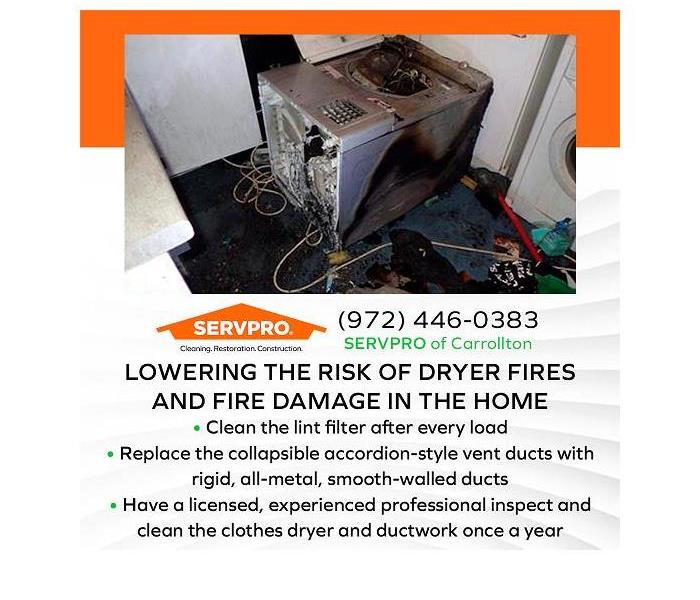How to reduce the fire damage risk associated with the use of a clothes dryer
3/9/2023 (Permalink)
Blog Summary: SERVPRO of Carrollton advises Carrollton, TX, homeowners on ways to reduce the risk of a dryer fire in the home.
The fire damage, smoke damage, and water damage restoration specialists at SERVPRO® of Carrollton offer this helpful advice on ways to lower the risk of dryer fires and fire damage in homes.
The first electric clothes dryer was patented in 1937. There are an estimated 89 million of these amazing, time-saving appliances in US homes. Most units are electric (75%), and the remainder (25%) is gas. Temperatures reach between 125 degrees Fahrenheit and 135 degrees Fahrenheit.
The National Fire Protection Association reported the following statistic on clothes dryer fires in the United States: “In 2014-2018, local fire departments responded to an estimated average of 13,820 home structure fires per year in which dryers were involved in the ignition. These fires caused an average of seven civilian deaths, 344 civilian injuries, and $233 million in direct property damage annually… One-third (32%) of dryer fires were caused by a failure to clean. This appears to be mainly lint build-up, as 27% of dryer fires started when dust, fiber or lint ignited.”
When given proper care and maintenance, these appliances operate efficiently and safely for anywhere from 10 to 13 years, depending on the frequency of usage per week. The typical family does about 7.4 loads of laundry per week, or about 5,200 loads over the course of 13 years, the maximum estimated lifespan of a residential clothes dryer.
Given that an estimated 266 clothes dryer fires are reported each week in the United States, fire prevention tips can help homeowners safely operate this appliance.
Tip #1. Clean the lint filter after every load
Some homeowners clean the dryer lint filter once a week or once a month, allowing the lint to build up and restrict airflow through the appliance. An enormous amount of lint can accumulate in the filter after only a single cycle when drying towels, diapers, or other lint-generating fabrics. Lint build-up creates a fire hazard and reduces the drying efficiency of the appliance due to the restricted airflow.
It literally pays to clean the lint filter after every cycle. The wet clothes dry faster. The stress on the appliance is reduced, adding to its longevity. The potential for fire decreases with the decrease in the amount of lint in the filter. Since the clothes dryer reaches temperatures of 135 degrees Fahrenheit, excessive strain on the system can elevate the operating temperature to dangerously high levels.
Some dryers have alerts to warn the homeowner that lint build-up adversely affects the appliance's performance. Some vent sensors are sensitive enough to detect partial blockages, while other detection systems only send an alert when the system experiences a total blockage. The more sensitive alert technology is superior, but not all appliances have this feature.
The best and safest practice is to check and clean the lint filter after every cycle. This habit ensures peak performance and safe operation of the appliance at all times.
Tip #2. Replace the collapsible accordion-style vent ducts with rigid, all-metal, smooth-walled ducts
Unlike the accordion-style ducts, which can droop and collect lint, the metal ducts allow air and lint to pass through the pipe with little or no resistance. If a metal duct system is installed, check for sheet metal screws that can snag lint, causing an eventual build-up. Use metal clamps or foil tape to connect sections of the ducts to ensure a tight seal and a smooth trip through the duct to the outside of the home.
Tip #3. Have a licensed, experienced professional inspect and clean the clothes dryer, and ductwork once a year
If drying time takes longer than usual, the culprit may be a blockage in the dryer vent system. A quick check of the outside vent should find warm air freely streaming from the vent. A thorough cleaning of the clothes dryer and vent system can be handled by a licensed professional, bringing peace of mind and a clean, efficient, and safe clothes dryer.
Bonus tip: Be very careful drying clothes that have been exposed to flammable liquids such as kerosene, diesel, gasoline, cleaning solvents, cooking oil, or other flammable chemicals. Wash contaminated clothing through two wash cycles. If weather permits, hang the clothing outside to dry. If the items must be run through the clothes dryer, set the appliance at the lowest heat setting for maximum safety.
For a fire, smoke, and water damage disaster caused by a clothes dryer clogged with lint, contact the professionals at SERVPRO of Carrollton. IICRC-certified technicians arrive at the client’s home in about an hour to begin the fire and water damage cleanup and restoration process. The rapid response and quick cleanup help return life to normal as soon as possible in Far North Dallas properties affected by fire damage disasters.
To learn more about water damage restoration in Carrollton, TX, call SERVPRO of Carrollton at (972) 446-0383 or email office@SERVPRO10952.com.

 24/7 Emergency Service
24/7 Emergency Service
